In the bustling world of online dating, two platforms have risen to prominence: eHarmony and Bumble. Whether you’re single and searching, or simply curious about the nuances of the dating app landscape, understanding the difference between using Bumble vs eHarmony is crucial. This article delves into each platform, offering insights into their algorithms, user experiences, and how they align with your goals – whether you’re into casual dating or in pursuit of relationships.
eHarmony: Engineered for Compatibility
eHarmony stands out in the realm of dating sites with its sophisticated algorithm designed to find you someone you like, based not just on physical attraction but on deep compatibility. This platform is perfect for individuals looking for something more substantial in their love lives. With eHarmony, the emphasis is on the long term, appealing to those who are ready to send the first message in a conversation that could lead to a mutual match made in heaven in an online dating game.

Comparing Dating App Benefits
| Feature | Bumble | eHarmony |
|---|---|---|
| User Base Size | 40 million users worldwide | Smaller, but more focused on serious users |
| Dating Style | Casual and flexible | Long-term and committed relationships |
| Ease of Use | Simple, user-friendly interface | More structured, requires detailed setup |
| Matching Algorithm | Behavioral matchmaking based on user activity | In-depth personality assessments for compatibility |
| Variety of Matches | Wide range of casual and serious relationships | Primarily serious, long-term relationship seekers |
| Communication Features | Variety of communication tools (messaging, flirts, etc.) | Guided communication system to foster meaningful connections |
| User Demographics | Diverse age groups and interests | Typically older, more relationship-focused users |
| Pricing | More affordable, with various subscription options | Premium pricing for higher success rates |
| Mobile Experience | Well-developed app with social media integration | Comprehensive app with detailed profiles and communication tools |
| Reputation | Popular for its flexibility and large user base | Highly regarded for fostering successful, long-term relationships |
Difference Between Bumble and eHarmony
| Feature | eHarmony | Bumble |
|---|---|---|
| Approach | Compatibility-based matchmaking | Women make the first move |
| Audience | Singles looking for long-term relationships | Diverse audience (dating, friendships, networking) |
| Features | Detailed personality assessment, curated matches | Swiping, women-message-first, BFF, Bizz |
| User Safety | Guided communication, privacy controls | Photo verification, privacy controls |
| Pricing | Subscription-based | Free, with optional premium features |
Messaging Features
- Bumble has a pretty different messaging system if you compare it to other dating sites, in that only women can make the first move in heterosexual matches, making conversations more concerted and less aggressive. The feature includes a 24-hour limit for starting and responding to messages, which drives quick interaction between users. For same-sex matches, either party can initiate communication. Bumble provides video and voice calls inside the app, so you never have to share your personal phone number.
- eHarmony, where communication features are more old-fashioned and paid users will be able to use it. Users who have been matched through the compatibility system can send messages to one another indefinitely. eHarmony offers structured communication options to help break the ice and have deeper conversations with your matches, providing yet another chance at a meaningful connection. It also offers video dating, allowing matches to see each other online before having a physical meeting, adding something very interesting to the core of this interaction.

Profile & Matching
- On Bumble, profiles are designed to be concise and visually engaging. Users can upload photos along with a brief bio and basic information such as age, occupation, and education. Bumble encourages users to link their profiles with social media platforms like Instagram to add authenticity and depth. The matching process is primarily based on geographical proximity and swipe mechanics, where users swipe right to like a profile and left to pass. Matches are made when two users mutually like each other’s profiles, but communication must be initiated by women in heterosexual matches.
- eHarmony offers a more detailed and thorough profile setup, requiring users to complete a comprehensive personality assessment during registration. This assessment is used to create a detailed personality profile that eHarmony uses to match users based on deep compatibility factors across various dimensions of personality. The profiles on eHarmony include a lot more information compared to typical dating apps, which helps in making more informed decisions. Matches are suggested based on these compatibility scores, and users receive a limited number of matches each day, emphasizing quality over quantity.
Customer Support Services
- Bumble’s primary customer support comes via in-app messaging and from their detailed FAQ, both available within the app and on their website. It allows users to report problems directly from their dating profile interface, which helps address inappropriate behavior, and technical issues. Bumble does offer an email support service; however, the response time is variable. The platform prides itself on community safety and provides quick responses to problems involving harassment, fake profiles, or abuse.
- eHarmony provides a more traditional kind of customer support, with no chat and only a comprehensive FAQ on their site, not even live help or social media. If you have more specific questions about the matching algorithm, billing issues, fake profiles, or account settings, their support team is available 24 hours a day—simply contact them and wait a few minutes to engage with an advisor. eHarmony generally has a good customer service department, likely due to the priority they put on maintaining long-term relationships and ensuring the integrity of their dating profiles.

Bumble: Empowering Connections
On the other side of the online dating spectrum is Bumble, a platform that revolutionized the way singles interact. Unlike traditional dating apps where anyone can initiate contact, Bumble requires women to send the first message, creating a safer and more respectful online environment. eHarmony vs Bumble is not just a comparison of features but of philosophies. While eHarmony focuses on compatibility, Bumble offers a more dynamic platform for not just dating but networking and making friends. Bumble and eHarmony cater to different needs but both aim to help you find someone special.
Pricing Comparison Chart
| Subscription Type | eHarmony | Bumble |
|---|---|---|
| Free | Basic membership with limited features | Full access with swipe limits |
| 1 Month | $59.95 | Bumble Boost: $24.99, Bumble Premium: $39.99 |
| 3 Months | $39.95 per month | Bumble Boost: $16.66 per month, Bumble Premium: $22.33 per month |
| 6 Months | $29.95 per month | Bumble Boost: $13.33 per month, Bumble Premium: $17.99 per month |
| 12 Months | $19.95 per month | Not available |
Tinder and the Dating App Landscape
When delving into the nuanced world of eHarmony vs Bumble dating sites, the conversation inevitably leads to Tinder, the colossus that transformed the dating app landscape with its pioneering swiping mechanism. This innovative feature not only revolutionized the way users engage with potential matches but also set a new standard for immediacy and simplicity in the online dating world. Yet, despite Tinder’s undeniable impact on the digital dating sphere, our analysis primarily focuses on eHarmony and Bumble for their distinctive methodologies in facilitating deeper, more meaningful connections, distinguishing them from the often fleeting and surface-level interactions commonly found on platforms geared towards casual dating.
Bumble vs eHarmony vs Hinge vs Plenty of Fish vs Okcupid Dating Sites
Here’s a comparison chart of several popular dating sites including Bumble, eHarmony, Hinge, Plenty of Fish, and OkCupid. The chart evaluates each platform across different criteria such as cost, user friendliness, suitability for enduring relationship, match quality, and inclusivity. Each criterion is rated on a scale from 1 to 5 to provide a clear comparative overview.

Incorporating Your Relationship Goals
Whether you’re navigating eHarmony vs Bumble, it’s essential to align the platform with your relationship goals. eHarmony is tailored for individuals seeking meaningful relationship, employing a comprehensive system to find a perfect match. Meanwhile, Bumble offers flexibility, catering to those who might be looking for something less serious but are open to the idea of a mutual match that could turn into more.
Conclusion: Bumble vs eHarmony in 2024?
In the digital quest for love, choosing between Bumble and eHarmony depends on the online dating experience you’re seeking. eHarmony offers a route towards committed relationships through deep compatibility, while Bumble provides a platform where women take the lead, challenging traditional dynamics and potentially leading to something meaningful.
Both dating sites have their merits, but your choice should reflect your personal goals. Whether you’re looking for casual encounters or dreaming of a deep connection, both Bumble and eHarmony offer paths to finding someone you like. With their unique algorithms and user-centric designs, these platforms stand at the forefront of the online dating experience, ready to help you find love and the perfect match.

FAQ:
1. What is the main difference between Bumble and eHarmony?
Bumble is a dating app where women make the first move in heterosexual matches. It emphasizes quick, location-based matches and encourages users to connect quickly. eHarmony, on the other hand, is more traditional and uses a detailed compatibility system to match users based on a comprehensive personality assessment, aiming forcommitted relationship.
2. Which platform is better for serious relationships?
eHarmony is generally considered better for those seeking serious relationships. It uses an extensive questionnaire to assess users’ compatibility with potential matches, focusing on creating meaningful connections. Bumble can also lead to committed relationship but is designed for a broader range of dating and social networking purposes.
3. How does the cost compare between Bumble and eHarmony?
Bumble offers a free version with optional premium subscriptions (Bumble Boost and Bumble Premium) that enhance the user experience. eHarmony typically requires a subscription to access most of its features, including viewing photos and sending messages, and tends to be more expensive than Bumble.
4. Which platform has a better success rate?
eHarmony claims to have a higher success rate in terms of – enduring relationship and marriages, largely due to its compatibility-based matching system. Bumble’s success rate can also be high but is more varied since it caters to everything from casual dating to serious relationships.
5. Can I use both Bumble and eHarmony on my phone?
Yes, both Bumble and eHarmony have mobile apps available for iOS and Android devices, allowing users to access their accounts and communicate with matches on the go.
6. Which app is more inclusive?
Bumble is known for its progressive approach to dating, offering modes for not only heterosexual couples but also same-sex couples and friendships (Bumble BFF). It also includes various gender options and preferences. eHarmony has traditionally been geared towards heterosexual relationships but has broadened its approach in recent years to include same-sex matches.
7. How do the matching algorithms differ?
Bumble’s algorithm is largely based on location and the preference settings selected by users, promoting quick matches. eHarmony’s algorithm uses data from its detailed personality test to match users based on multiple dimensions of compatibility, aiming for deeper connections.
8. Which site is more user-friendly?
Both platforms are designed to be user-friendly, but Bumble’s interface is often considered more modern and simpler to navigate, especially for younger users. eHarmony’s interface is also user-friendly but involves more steps and information due to its comprehensive profiling and matching process.
9. What type of privacy features do Bumble and eHarmony offer?
Both Bumble and eHarmony place a high priority on user privacy and safety. Bumble allows users to verify their profiles to increase trustworthiness and has features like private detector, which blurs lewd images. eHarmony also offers robust privacy features, including secure communication channels and detailed privacy settings.
10. How do I choose between Bumble and eHarmony?
Your choice depends on what you’re looking for in a relationship and how you prefer to interact with potential matches. If you’re into fast-paced, straightforward dating or networking, Bumble is suitable. If you’re looking for a long-term, deeply compatible relationship, eHarmony might be a better choice due to its detailed matching algorithm and focus on compatibility.
More reviews worth reading:
- eHarmony Review & Walkthrough
- Hinge Dating App Review
- FriendFinder Review & Walkthrough
- Christian Mingle vs. Upward
- Chemistry.com Review & Walkthrough
- Exploring Christian Cafe Cost
References:
Krzywicki, A., Wobcke, W., Kim, Y. S., Cai, X., Bain, M., Mahidadia, A., & Compton, P. (2015). Collaborative filtering for people-to-people recommendation in online dating: Data analysis and user trial. International Journal of Human-Computer Studies
Jill Sutie (2015) How is Technology Shaping Romance? Greater Good Magazine
Edwin L. Aguirre (2016) Researchers Develop a Matchmaking Program. Edwin L. Aguirre
Anna Baluch (2024) “Bumble Review: Is It Worth Using?” Forbes Health
Contributing Author:
Bumble and eHarmony are two of the bigger players in an ever-growing industry. One of the key differences is Bumble’s women-first approach, in which only women can initiate a conversation that helps create an empowering and respectful environment. It is also ideal for beginners due to its ease of use. For the long-term minded individuals seeking out life partnerships, eHarmony is a classic because it prides itself on its intricate matching system based on hundreds of questions that you each complete. Many claim the deep compatibility factors mean that users are far more likely to find a long-term relationship through these means. Since both platforms serve the interests of various dating groups, they are useful regardless if you came to them for casual hookups or committed relationships.



